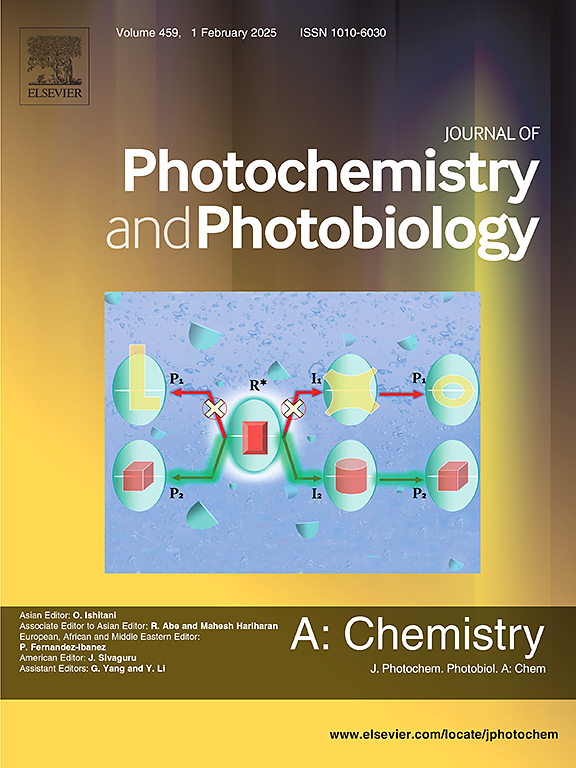Rapid colorimetric sensing assay based on gold nanoparticles combined with discrete wavelength transform- intelligent fuzzy inference system for the simultaneous determination of antibiotic drugs in biological fluid and injection vial powder
IF 4.7
3区 化学
Q2 CHEMISTRY, PHYSICAL
Journal of Photochemistry and Photobiology A-chemistry
Pub Date : 2025-06-23
DOI:10.1016/j.jphotochem.2025.116596
引用次数: 0
Abstract
Determining drugs in pharmaceutical formulations, urine, and plasma samples is crucial. For this purpose, chromatographic methods are commonly used. However, this method is expensive, time-consuming, and requires complex instruments. In contrast, the colorimetric method using a UV–Vis spectrophotometer along with chemometric approaches can be employed for the simultaneous determination of trace components in real samples. In this study, a colorimetric assay combined with discrete wavelength transform (DWT) incorporated with principal component analysis (PCA) and fuzzy inference system (FIS) was presented for the simultaneous determination of ultra-trace of two antibiotics named imipenem (IPM) and cilastatin (CS) in binary mixtures and biological samples using localized surface plasmon resonance (LSPR) of citrate-capped gold nanoparticles (Citrate-AuNPs). The detection of these drugs was carried out by observing the color change of the AuNPs solution from red to blue due to the aggregation induced by both components. The aggregation of citrate-AuNPs was characterized by transmission electron microscopy (TEM), dynamic light scattering (DLS), and UV–Vis spectrometry. The linear calibration graph was achieved within a concentration range of 200–1000 μg/L for IMP and 50–800 μg/L components with a limit of detection (LOD) of 30.55 μg/L for IMP and 33.00 μg/L for CS, while the limit of quantification (LOQ) was 92.60 and 100.00 μg/L for IMP and CS, respectively. Various wavelet families named Daubechies with the second order (db2), db of order 4 (db4), and Coiflet of second order (coif2) were used to decompose the absorption of binary mixtures containing IMP and CS in the DWT method. After applying dimensionality reduction by PCA, two inputs entered the environment of the FIS. The best wavelet family was coif2 in combination with FIS with a coefficient of determination (R2) of 1, root mean square error (RMSE) lower than 2.2, and mean recovery higher than 99 % for both components. The analysis of IMP and CS in spike human urine samples revealed that mean recovery was higher than 96 % and RSD was lower than 1.6 %. The injection vial powder containing IMP and CS analysis was done by the proposed approach and the HPLC method, and the absence of any significant difference between these two methods was measured by the analysis of variance (ANOVA) test. The suggested colorimetric method was found to be easy, selective, sensitive, and quick toward pharmaceutical components, which detects IMP and CS within minutes with the naked eye and without the need for sophisticated instruments. On the other hand, the simultaneous quantitative determination of the mentioned components in different samples (pharmaceutical formulation and biological fluids) can be used, which is faster and easier than common chromatographic methods.

基于金纳米颗粒结合离散波长变换智能模糊推理系统的快速比色传感法同时测定生物液和注射剂中抗生素药物
确定药物配方、尿液和血浆样本中的药物至关重要。为此,通常使用色谱法。然而,这种方法昂贵、耗时,并且需要复杂的仪器。相比之下,使用紫外-可见分光光度计的比色法和化学计量法可以用于同时测定实际样品中的痕量成分。本研究采用离散波长变换(DWT)、主成分分析(PCA)和模糊推理系统(FIS)相结合的比色法,利用柠檬酸盐包盖金纳米粒子(cit酸盐- aunps)的局部表面等离子体共振(LSPR)同时测定二元混合物和生物样品中亚胺培南(IPM)和西司他汀(CS)两种抗生素的超痕量。这些药物的检测是通过观察AuNPs溶液由于两组分的聚集而由红色变为蓝色来进行的。通过透射电镜(TEM)、动态光散射(DLS)和紫外可见光谱(UV-Vis)对柠檬酸盐- aunps的聚集进行了表征。在200 ~ 1000 μg/L和50 ~ 800 μg/L浓度范围内均可建立线性标定图,IMP和CS的检出限分别为30.55 μg/L和33.00 μg/L, IMP和CS的定量限分别为92.60和100.00 μg/L。在DWT方法中,利用二阶Daubechies (db2)、四阶db (db4)和二阶Coiflet (coif2)等不同的小波族对含有IMP和CS的二元混合物的吸收进行分解。采用主成分分析法降维后,两个输入进入FIS环境。最佳小波族是coif2和FIS组合,决定系数(R2)为1,均方根误差(RMSE)小于2.2,两分量的平均回收率均大于99%。结果表明,该方法的平均回收率大于96%,RSD < 1.6%。采用该方法和高效液相色谱法对含IMP和CS的注射小瓶粉末进行分析,并采用方差分析(ANOVA)检验检验两种方法之间是否存在显著差异。该比色法对药物成分具有简单、选择性好、灵敏度高、快速等特点,可在几分钟内用肉眼检测IMP和CS,无需精密仪器。另一方面,可以同时对不同样品(制剂和生物液)中的上述成分进行定量测定,比普通色谱法更快、更容易。
本文章由计算机程序翻译,如有差异,请以英文原文为准。
求助全文
约1分钟内获得全文
求助全文
来源期刊
CiteScore
7.90
自引率
7.00%
发文量
580
审稿时长
48 days
期刊介绍:
JPPA publishes the results of fundamental studies on all aspects of chemical phenomena induced by interactions between light and molecules/matter of all kinds.
All systems capable of being described at the molecular or integrated multimolecular level are appropriate for the journal. This includes all molecular chemical species as well as biomolecular, supramolecular, polymer and other macromolecular systems, as well as solid state photochemistry. In addition, the journal publishes studies of semiconductor and other photoactive organic and inorganic materials, photocatalysis (organic, inorganic, supramolecular and superconductor).
The scope includes condensed and gas phase photochemistry, as well as synchrotron radiation chemistry. A broad range of processes and techniques in photochemistry are covered such as light induced energy, electron and proton transfer; nonlinear photochemical behavior; mechanistic investigation of photochemical reactions and identification of the products of photochemical reactions; quantum yield determinations and measurements of rate constants for primary and secondary photochemical processes; steady-state and time-resolved emission, ultrafast spectroscopic methods, single molecule spectroscopy, time resolved X-ray diffraction, luminescence microscopy, and scattering spectroscopy applied to photochemistry. Papers in emerging and applied areas such as luminescent sensors, electroluminescence, solar energy conversion, atmospheric photochemistry, environmental remediation, and related photocatalytic chemistry are also welcome.

 求助内容:
求助内容: 应助结果提醒方式:
应助结果提醒方式:


